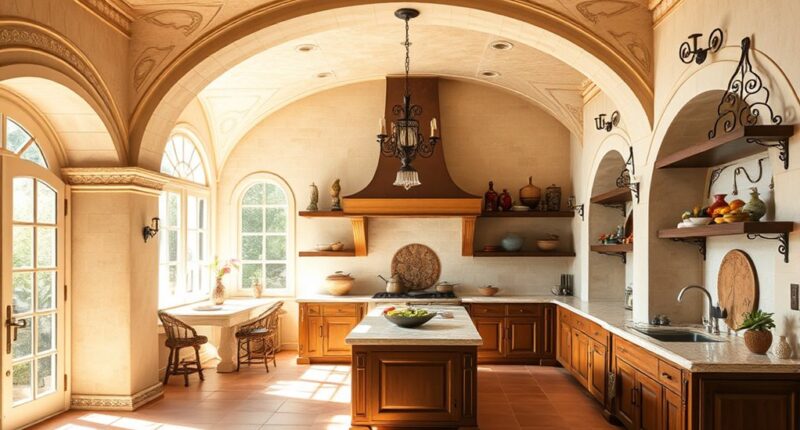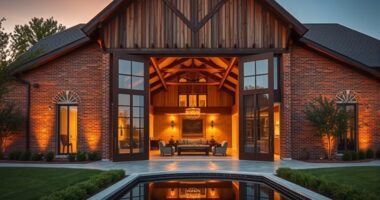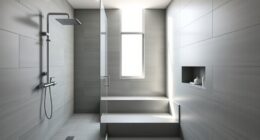In this Mediterranean Revival kitchen, expertly crafted arches feature complex curvature supported by reinforced steel and keystones that evenly distribute weight. Textured plaster finishes, applied in multiple layers with hand tools, mimic aged, sun-baked walls, enhancing authenticity and depth. Precise joint detailing ensures seamless shiftings and crack prevention, while textured surfaces improve durability. Technical execution reflects traditional techniques adapted for modern construction, creating an environment where craftsmanship meets structural integrity—discover how these details contribute to the overall aesthetic and resilience.
Key Takeaways
- The kitchen features gracefully curved arches with complex profiles, enhancing Mediterranean aesthetic and structural flow.
- Textured plaster finishes emulate traditional Mediterranean walls, adding depth and authentic character.
- Keystones are carefully aligned to distribute weight evenly and maintain visual harmony.
- Expert craftsmanship applies multiple plaster layers for durable, textured surfaces with irregularities for realism.
- Precise joint detailing ensures seamless transitions between arches and flat surfaces, preventing cracks and enhancing aesthetics.

The Mediterranean Revival Kitchen masterfully combines architectural authenticity with meticulous craftsmanship, emphasizing key design elements such as gracefully curved arches and textured plaster finishes. These features serve not only to evoke the historic charm of Mediterranean architecture but also to demonstrate a precise understanding of traditional techniques adapted for contemporary construction. As you approach this space, you’ll notice the arches’ complex curvature, which requires precise geometric calculations and skilled masonry to achieve seamless, structural integrity. These arches are often constructed using a combination of steel reinforcement and carefully shaped masonry or plaster forms, ensuring they support the load above while maintaining an elegant, fluid profile. The keystones, meticulously aligned, serve both aesthetic and structural functions, distributing weight evenly across the curve to prevent cracking or deformation over time.
The arches’ complex curvature and keystones exemplify precise craftsmanship ensuring both beauty and structural integrity.
Moving to the textured plaster finishes, the craftsmanship hinges on selecting the appropriate plaster mix—often a combination of lime or cement-based materials with additives to achieve desired textural effects. The application process involves multiple layers, each carefully applied and troweled to create a surface that mimics the aged, sun-baked walls characteristic of Mediterranean architecture. The texture is not merely superficial but integral to the wall’s durability and aesthetic appeal, providing a tactile quality that enhances the authentic look. The plaster is often hand-applied, with artisans using specialized tools to create variations that reflect historical plastering techniques, such as the irregularities and subtle undulations that add visual depth and character. Additionally, understanding the color fidelity of the plaster can greatly influence the final authentic appearance, ensuring that the hues and textures resonate with traditional Mediterranean styles.
The integration of these elements demands rigorous attention to detail. For example, the transition zones between arches and flat surfaces require precise joint detailing to prevent cracks and guarantee seamless visual flow. This involves careful planning of expansion joints and the use of compatible materials that accommodate thermal movement, preventing stress accumulation that could compromise the structure’s integrity. The plaster finishes are also sealed with appropriate breathable sealants, allowing moisture regulation and preventing deterioration over time—a critical consideration in maintaining long-term authenticity.
Throughout the project, you’ll observe a deliberate emphasis on craftsmanship, where each component—whether it’s the curvature of an arch or the texture of a plaster wall—is executed with technical precision. This ensures not only the structural soundness but also the aesthetic harmony that defines the Mediterranean Revival style. The careful selection of materials, combined with expert application techniques, results in a space that feels both historically rooted and resilient, embodying the craftsmanship and architectural integrity that set this kitchen apart.
Frequently Asked Questions
What Are the Typical Color Palettes Used in Mediterranean Revival Kitchens?
You typically choose warm, earthy color palettes for Mediterranean revival kitchens, including terracotta, ochre, burnt orange, and deep reds. These hues are complemented by cool accents like turquoise, cobalt, or aquamarine to mimic the coastal influence. You often see white or cream plaster walls that enhance brightness and contrast beautifully with the richer tones. This combination creates a vibrant yet harmonious space that evokes the relaxed, sun-drenched ambiance characteristic of Mediterranean design.
How Long Does It Usually Take to Complete an Arch Installation?
It usually takes about one to two days to complete an arch installation, depending on complexity and site conditions. You’ll need to prepare the framework, carefully shape the arch, and guarantee precise mortar work for stability. If the arch involves intricate detailing or custom plaster finishes, allocate additional time for curing and finishing touches. Remember, rushing can compromise quality, so plan for some buffer time to achieve a flawless result.
What Maintenance Is Required for Plaster Walls in This Design Style?
You should inspect plaster walls regularly for cracks, chips, and moisture infiltration. To maintain their integrity, clean them with a soft, damp cloth and avoid harsh abrasives. If you notice cracks or damage, promptly fill them with a compatible plaster or patching compound and repaint as needed. Keep humidity levels controlled to prevent deterioration, and consider sealing the surface with a breathable sealant to protect against moisture while maintaining the authentic Mediterranean aesthetic.
Are There Sustainable Materials Suitable for Mediterranean Revival Kitchens?
Yes, you can use sustainable materials in Mediterranean Revival kitchens. Opt for reclaimed wood for cabinetry, eco-friendly clay or lime plasters for walls, and recycled glass or ceramic tiles for backsplashes. These materials reduce environmental impact, offer durability, and maintain the authentic aesthetic. Additionally, choosing low-VOC paints and energy-efficient fixtures complements the sustainable approach, ensuring your kitchen remains both beautiful and eco-conscious.
Can Modern Appliances Be Integrated Into This Traditional Aesthetic?
Yes, you can seamlessly integrate modern appliances into a Mediterranean Revival kitchen by choosing sleek, minimalist designs that complement traditional elements. Opt for built-in or panel-ready appliances that blend with plaster walls and arched doorways. Use warm metallic finishes, like bronze or matte black, to harmonize with terracotta tiles and stucco surfaces. Proper placement and concealed wiring guarantee functionality without disrupting the authentic aesthetic.
Conclusion
As you step into the Mediterranean Revival kitchen, the interplay of traditional arches and smooth plaster creates a timeless yet dynamic space. The structural precision of the arches contrasts with the organic texture of the plaster, highlighting craftsmanship and materiality. This synergy balances aesthetic elegance with functional integrity, transforming the room into a sanctuary of cultural heritage and modern refinement. In this juxtaposition, you find a space that’s both rooted in history and boldly contemporary.









